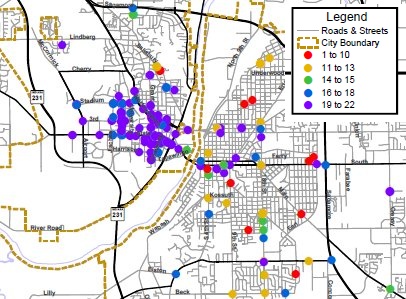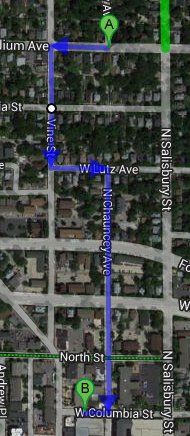In April 27th’s Sunday paper, Dave Bangert writes Drivers, cyclists and a mirror of shared blame, discussing the recent APC study regarding bicycle crashes in Tippecanoe County from 2007 – 2012.
The report is a good reference point with statistics, maps, and suggestions. Crashes are denoted by time of day, weather conditions, etc.
In this particular map (page 18), it shows the location of the crashes and their density by color.
The report does not state if the cyclist had proper gear on their bicycle. For instance, I cannot find the words bell, whistle, siren, or audible in the report.
In my own riding, I find that, during daylight hours, my bell is the most important piece of equipment on my bicycle.
Per Title 9 of the Indiana Code, a bicycle should have something that makes noise that is not a siren or whistle. Yelling also does not count, however, communicating On your left! is helpful and respectful.
IC 9-21-11-8
Bell or other audible signaling devices; sirens; whistles
Sec. 8. A person may not ride a bicycle unless the bicycle is equipped with a bell or other device capable of giving a signal audible for a distance of at least one hundred (100) feet. A bicycle may not be equipped with and a person may not use upon a bicycle a siren or whistle.
As added by P.L.2-1991, SEC.9.
Making everyone mindful that a bicycle is present is one of the most important defensive riding techniques one can employ. If you don’t have a bell, I highly recommend purchasing one ASAP. I personally use a Crane and find them to be amazing in their clarity and have a pleasant tone. You can purchase them at Virtuous Cycles in Downtown Lafayette.
Another disturbing aspect in Bangert’s article is the mentioning of Purdue’s recent plan suggestions (emphasis is mine). If anyone has a full link to this report and/or suggestions, I would greatly appreciate it.
Purdue is paying $150,000 to consultants Rundell Ernstberger Associates of Muncie and Toole Design Group of Silver Spring, Md., to develop an integrated bicycle master plan and make recommendations on commuter routes to and from campus. During a public meeting Thursday, the consultants outlined a number of suggestions, including possible “contraflow” lanes that would allow cyclists to ride against traffic on one-way streets, separated bike paths through and near campus, better designed intersections and curbs, and better driver and cyclist education campaigns. A lot of it, consultants repeatedly said, could be done, perhaps with just some paint, “on day one.”
Creating contraflow lanes is a myopic and foolhearted endeavor that will only lead to greater confusion and possibly disastrous cognitive dissonance. I would be curious about the empirical data to back up this suggestion, especially in the context of Purdue.
Our traffic system in #greaterlala is not that complicated. It may be perceived as an inconvenience to ride a couple of streets over, but you are on a bicycle. Pedal a bit.
For instance, this is my path to the West Lafayette Public Library. I avoid going the wrong way on Vine St.
It appears, based on this and other suggestions, that we as a community wish to lower our standards for cycling by providing exceptions to the rules so people can ride in illogical and less predictable ways.
I have similar concerns over the State Street (Traffic) Master Plan‘s inclusion of bike lanes on campus. Turn off the bike lane and you have to become a car again. Enter downtown Lafayette and the same is true.
Portions of the cycling community believe that since we are not wrapped in metal and are powering ourselves by way of our own bodies, we somehow elevate to the status of magical pedestrian, able to bend traffic rules and laws at will.
These types of suggestions do nothing but prevent us from evolving into a predictable agent of travel, by whatever means we choose to transverse the land.
Be mindful out there. Use your bell. When it’s dark, use your lights as well.
Ride safe.

